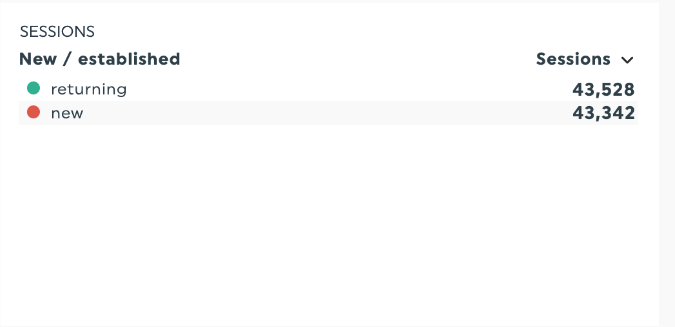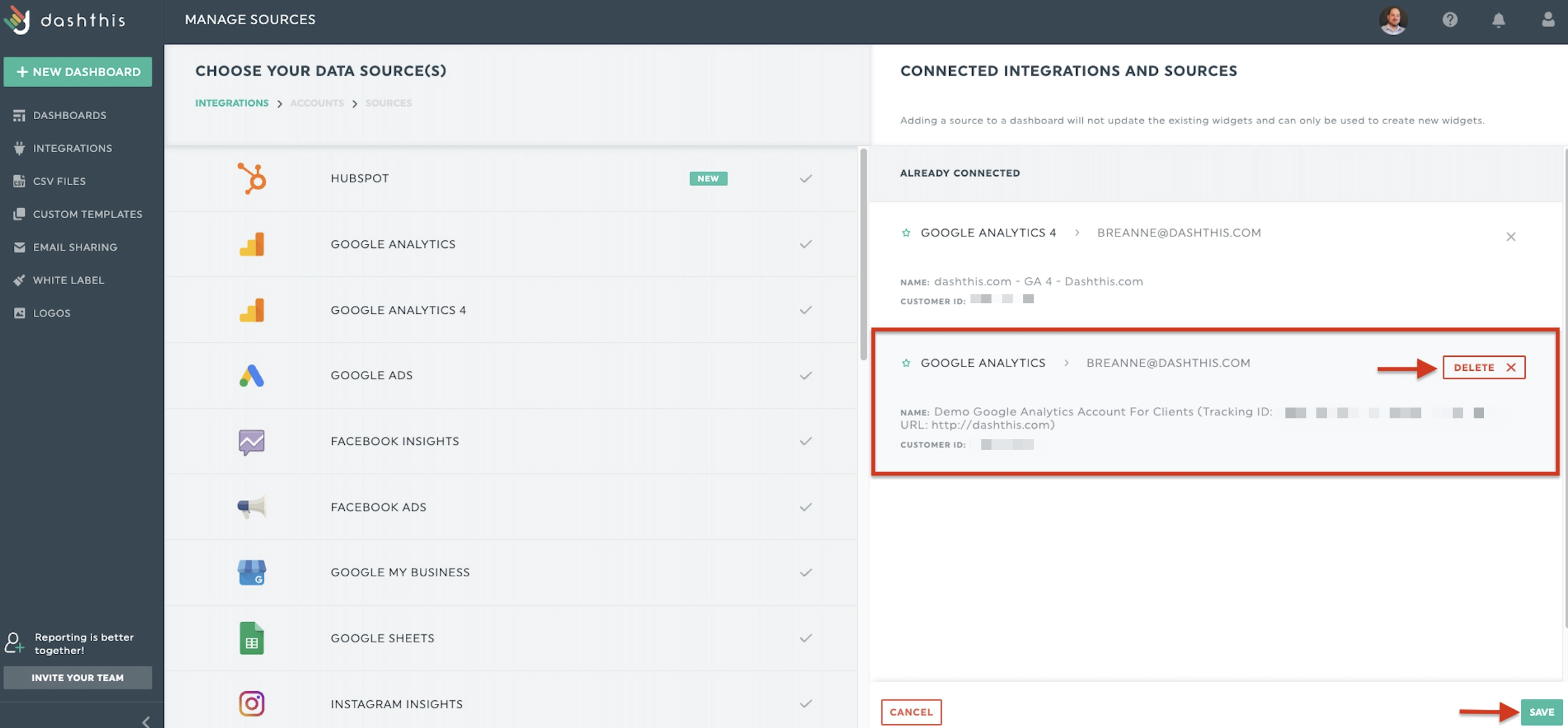GA4 Migration part 2: How to Successfully Implement GA4, Key metrics, and Reporting with Dashthis

- Recap V1
- Dimensions (automatic and custom) + comparative
- Creating widgets with a dimension in DashThis
- How to
- Valuable KPIs
- Source-medium
- Filters
- My Universal historical data
- How to remove universal from dashthis in ‘’manage data sources’’
- Sunset update
1. Recap V1
In February 2023, we took the initiative to provide our clients with a step-by-step guide on migrating from Google Analytics Universal to Google Analytics 4. In that guide, not only did we talk about Google’s migration process as user-friendly as possible but we also provided you with a complete list of comparative metrics and dimensions between ua and ga4 and recommended to you some best practices within your DashThis dashboards.
We hope the content in our GA4 migration guide helped you with your process, but if you still need to read it, what are you waiting for? 😉
Even though we covered a lot of great content in the first guide, the main goal of it was to help facilitate your ga4 transition in a step-by-step process. With that being achieved, Google Analytics 4 is still evolving every day as we get closer to the sunset date (July 1st, 2023) - we would be happy to see you continue your GA4 educational journey with us.
In this new blog post about Google Analytics 4, we would like to discuss some topics such as preset and custom parameter dimensions - how to create dimensioned widgets in DashThis with filters while deep diving into source mediums and mentioning some valuable digital marketing KPIs. We’ll look into how to remove universal analytics sources from your dashboards quickly, and, lastly, we will bring up more information about the GA4 sunset and what happens to your data!
2. Dimensions (automatic and custom) + comparative
In Google Analytics, dimensions are populated automatically to help break down numeric data (metrics); for example, breaking down the total views number (metric) per page title and screen class (dimension) will give you your overall finer results.

Google Analytics 4 offers a good selection of dimensions that populate data automatically. The list of dimensions is quite similar to Universal but Google decided to go the extra mile in their new interface. GA4 now gives you the possibility to configure custom dimensions. You can create up to 50 custom dimensions per property and 25 user-scoped custom dimensions to feed into your ga4 reports no matter if your data stream is web or app! More information regarding Google’s GA4 custom dimensions can be found here: Learn more.
Custom dimensions (and metrics) are available when creating a report in DashThis - We'll discuss this in the next topic below. Note that we do not have restrictions on creating widgets with a custom metric and a custom dimension! 😁
Our GA4 migration guide provided a list of comparative ua and ga4 metrics and dimensions to help you create new or modify existing reports. We promised our customers 19 new metrics and 20 new dimensions + custom dimensions to be delivered by March 2023; we’re happy to let you know these were successfully added! Should Google add new metrics and dimensions to its API, we will keep an eye out during the second quarter of 2023. Let our customer success team know if you have any specific KPIs, you would like to add but don’t see them. In the meantime, you can create these KPIs via a custom metric or dimension directly in Google.
3. Creating widgets with a dimension in DashThis
How to: Before making marketing decisions, you and your customer must have a comprehensive understanding of what their business goals are. Whether they want to increase sales, bring more traffic to their site, or improve customer engagement, a new marketing strategy plan may arise as new metrics, dimensions, and measurement enhancements are available with GA4. Additionally, you’ll need to ask yourselves if you want to keep universal data co-existing within GA4, use it for future reporting references or customer questions, or remove universal from your reporting. Defining these goals, KPIs, and reporting decisions is important before creating a new dashboard your customer may not understand.
Once a new or existing marketing plan has been established, now is a good time to create your dashboard! Creating a widget with a metric and dimension in DashThis is a pretty straightforward process. All you need to do is go inside your dashboard (or create a new one) and click on the custom widget under the widget menu to the left. As previously mentioned, widgets with dimensions are available with the following graph types: List, Multi-list, Stacked-column, or Pie chart. Once you’ve chosen your graph type, (1) choose your metric (2) choose your dimension (automatic or custom)
Valuable KPIs: When choosing your GA4 metrics and dimensions, here are some valuable KPIs you might want to create together in your report. *Note: Custom dimensions may play a very important part in your most valuable KPIs but are not mentioned below as these are created at your own discretion.
- Website Traffic Overview
Metrics: Sessions, New users, Total users, Views, Bounce Rate, Session Conversion Rate
Dimensions: Country, Session Default Channel Grouping, Source/medium, First user Source/Medium, Session source/medium, Page Path + Query String, New / Established
- SEO (Search Engine Optimization)
Metrics: Sessions, Engagement Rate, Conversions, Users, New users,
Dimensions: Landing Page, Page Referrer, Day of Week, Campaign
- SEM (Search Engine Marketing )
Metrics: Advertiser Ads Impression, Advertiser Ads clicks, Conversion rate, Advertiser Ads Cost per Clicks, Cost per Conversion
Dimensions: Location, Device, Time of day, Session Manual Ad Content, Google Ads ad network type, Google Ads Query
Source/Medium: One of the most popular analytic reports within Universal is the Source/Medium Report because using it shows you where the most effective traffic source is coming from but what do these attributes mean?
- Source is WHERE your website or app traffic comes from (individual websites, Google, Facebook, etc).Medium is HOW it got there (organic traffic, paid traffic, referral, email, etc).

In Google Analytics 4 now, there are 3 types of dimensions related to traffic sources:
- The plain ones as we know best (for example, Session, Medium, Campaign, etc.)
- The ones that start with ‘’First user’’ *new
- The ones that start with ‘’Sessions’’ *new
But what do these new dimensions mean?
- First user-scoped dimension (First user source/medium) means the website, app, and marketing channel by which the user was first acquired.
- Session-scoped dimension (Session source/medium) which means the source and medium that was associated with the start of a session of your website or app.
How do you use ‘’source/medium’’ in your DashThis report? First, you’ll need to consider creating a widget with metrics and dimensions (List, Multi-list, Stacked-column, or Pie chart) Common metrics to this dimension that you can consider are New users, User engagement duration, Session conversion rate, and Engagement rate. However, only the engagement rate is compatible with the dimension Source/Medium. The other metrics must be used with first user or session dimensions.
For example, you can create these results in a multicolumn list within your DashThis report:

- Filters: After establishing which metrics and dimensions you want to create in your report, you can also select a filter to narrow down your GA4 analytics data which is of course optional. A filter doesn’t need to be applied right away, you can always create your widget first, see which results are displayed, and then go into the widget settings > click on basic settings - the mechanical gear icon and apply a filter afterward.
For example, if you only want to see your Sessions dimensioned by New and Established users but do not want to display the (not set) - PS. Not sure what ‘’Not Set’’ means? Check out Google’s explanation.

Go into your widget settings - choose basic settings - scroll down to the filter option and enter the following:
Category: New / established
Rule: Does not contain
Filter name: (not set)


And there we have it! We created a dimensioned metric and filtered the results!
Additionally, like Universal, GA4 uses Regular expressions (Regex). So if you are already used to using them and where to apply them, you can make your reports even more flexible; however, you must choose one of the "Matches regexe" or "Does not match regex" operators.
Should you need assistance with GA4 metrics, dimensions, or filters, please don’t hesitate to check out our Help Center or contact our Support Team!
4. What happens to my Universal historical data
As the Universal sunset approaches, a lot of concerns are arising when it comes to historical data. Just know that if you intend on keeping Google Analytics Universal in your reports, you can keep your UA widgets created in DashThis, we will store your historical data as long as the widgets remain created.
To continue helping our customers with this major shift in the digital marketing world, we are currently working on a dashboard archive feature so you can still consult your dashboards that have universal data and use it to compare with past data or to keep for client questions. Should you not wish to keep your universal data in DashThis, no problem; the next section is for you!
5. Remove Universal from existing dashboards + what happens to my historical data
Our first guide showed you how Universal and GA4 coexist within the same dashboard. As we move closer to the sunset, we’ve surveyed our customers and the industry to know how marketers plan on using universal data after the sunset. The results are interesting as many marketers will continue to report both data from Universal and GA4; however, since measurements are not the same, it will be difficult to keep up with old marketing decisions so, many will not use it at all. If this applies to you, just know that you can quickly remove universal widgets from your dashboard by deleting the source under manage data sources.
There are two ways to access this page.
Option 1 - Via your dashboard manager. Search for your dashboard, click the options button to the right, and then select manage data sources. Choosing the first option avoids having to go inside your dashboard if you do not want to open it; however, we recommend that you take the time to view your KPIs to make sure that you really want to delete them as this is a permanent action once completed and cannot be retrieved.
Option 2 - In your dashboard, you can access the dashboard settings gear (right-hand side) and click on manage data sources

Hover your mouse over the Google Analytics account that you want to remove. Click on delete and then save. Note: once deleted this is a permanent action once completed and cannot be retrieved.
At any time, you can export your reports by downloading them as a PDF via the dashboard settings + click on the share icon + download as a pdf.

6. Sunset update
We are still actively monitoring Google’s sunset, at this time there have been no changes announced. Should you wish to follow Google updates, please visit their ‘’What’s new’’. Rest assured that we intend to communicate any changes related to the migration as soon as we are informed.
Should you have any questions about Google Analytics (Universal & GA4), please contact our Support Team.
Happy Reporting
The DashThis Team
Ready to create a GA4 report with Dashthis?
Read More

Don’t miss out!
Automate your reports!
Bring all your marketing data into one automated report.
Try dashthis for free
